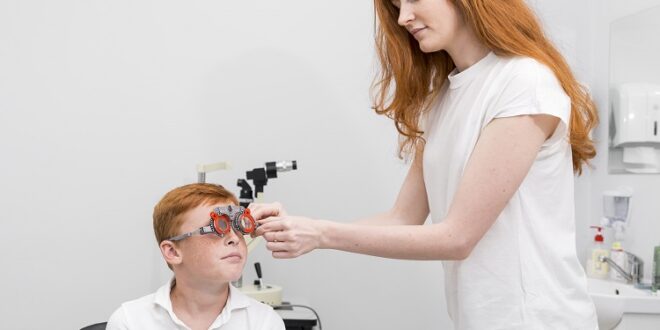It can be hard to deal with a diagnosis of low vision, but these 6 steps will help you come up with an actionable plan. Low vision is a broad term that encompasses many different diagnoses, such as macular degeneration, glaucoma, cataracts, and diabetic retinopathy. We’ll talk about the most common ones and provide resources for you to find more information.
- Be an advocate for yourself
- Tackle your financial concerns
- Reach out
- Adopt healthy habits
- Find practical solutions
- Visit Low vision clinic
Be an advocate for yourself
When it comes to your vision, it’s important to be your own advocate. If you have any questions about your eyesight, talk to your primary eye care professional. If they don’t refer you to a low vision specialist or suggest you research specialists in your area, ask for a referral. You should go in as soon as possible, before your vision worsens.
Low vision specialists are trained to optimize the remaining sight of their patients. They have access to tools that are not commonly used in regular eye exams. The goal is to gather as much information as possible about your vision, and find a solution that will help you meet your goals.
There are many ways for you to find a specialist. One way is to Google search “low vision specialists near me” or “low vision clinics near me.”
Tackle your financial concerns
There are three things to think about when it comes to the financial burden of low vision: eye care expenses, adaptive technologies, and vision rehabilitation services. Here are some resources to help you handle each one of these issues.
If you have employer-provided insurance, vision benefits may be included. If not, the first step is to explore what your private insurance covers. It is also important to note that low vision may qualify you for disability benefits if it prevents you from working, regardless of age.
Some organizations have funds for low-vision individuals. If you’re eligible, you may be eligible for a low or no-interest loan to purchase a device to help with low vision. You could also get it for free. Contact your local branch for more information.
Under the Assistive Technology Act, each U.S. state has a program to promote access to assistive technology devices and services. This program was created to increase awareness of these devices and services by U.S. citizens. If you are a veteran, the VA offers rehabilitation programs for people with visual impairments. These services include low-vision clinics, visual impairment centers to optimize remaining sight, and technology assistance.
Reach out
Stay connected with family and friends. It’s important that they know about the diagnosis, and you should be comfortable sharing it. Low vision support groups are a useful resource for those facing a new diagnosis. These groups are full of people who are all living with low vision, and members offer each other emotional support and coping strategies. Some groups have online options for people who can’t meet in person. These are formal meetings led by a trained psychologist, or more informal gatherings.
Adopt healthy habits
Studies have shown that specific nutrients can reduce the risk of developing advanced AMD (dry or wet) in people who already suffer from macular degeneration. Rates of cataracts and glaucoma may also be reduced, as well as the risk of blindness. Antioxidants and other key nutrients are thought to play a role in this.
Here are the nutrients and foods you should try to incorporate into your diet.
- Lutein and Zeaxanthin: Green leafy vegetables such as spinach, kale, and collards. You can also find them in eggs, broccoli, pumpkin, and bright-colored fruits such as kiwi and grapes.
- Vitamin A: Fish, milk, eggs, beef liver, spinach, pumpkin, carrots, and sweet potatoes.
- Vitamin C: Red and green peppers, cauliflower, broccoli, papaya, cantaloupe, brussels sprouts and Fruits like oranges, berries.
- Vitamin E: Almonds, pecans, sunflower seeds, wheat germ oil, fortified cereals, vegetable oils, and peanut butter.
- Zinc: Oysters, crab legs, red meat, poultry, baked beans, and whole grains.
- With proper nutrition and exercise, people can reduce their risk of a number of eye diseases, including cataracts, glaucoma, and wet age-related macular degeneration.
Find practical solutions
After being diagnosed with low vision, most people feel devastated. This is because our vision helps us with just about every task – from waking up in the morning to sleeping at night. Luckily, there are a range of technology solutions that will help you adjust to life with low vision.
We all know what it’s like when we first try a new technology. For instance, maybe you’re not sure how to use a tablet or laptop for the first time. Just remember to be patient with yourself. That’s because, in the beginning, you won’t know anything about these things. They may seem complicated and overwhelming at first. But don’t worry – if you contact experts and go at your own pace, you can learn anything.
Visit Low vision clinic
Low vision specialists at Low vision clinics can help you learn how to use your remaining vision more efficiently. They work with you to analyze your activities and find environmental modifications to help you succeed. Low Vision Specialists are committed to helping people with vision loss. They specialize in products that maintain independence, mobility, and safety.
 HammBurg Be informed with latest news, reviews, entertainment, lifestyle tips, and much more.
HammBurg Be informed with latest news, reviews, entertainment, lifestyle tips, and much more.




